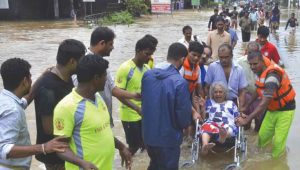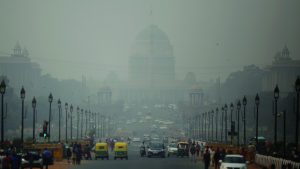 The first Monday of November saw the air quality in Delhi dipping to its worst low of the season. Just two days before Diwali and barely a week after the Supreme Court put cursory restrictions on the sale and use of crackers in the national capital, the pollution levels inched towards ‘severe plus emergency’ category due to change in wind direction and rampant stubble burning in neighbouring states. After breathing the cleanest air in three weeks on the preceding Sunday, people woke up to a gloomy Monday, with a thick haze covering the sky. According to the data from the Central Pollution Control board (CPCB), the PM2.5 (particles in the air with a diameter less than 2.5 micrometers) and PM10 concentrations touched 365 and 503 respectively. Most of the NCR region recorded ‘severe’ pollution, with Gurgaon recording ‘very poor’ air quality. This is just another warning sign of the rapidly deteriorating Indian climate in a year that was inundated with dust storms, floods and vast variations in daily temperatures.
The first Monday of November saw the air quality in Delhi dipping to its worst low of the season. Just two days before Diwali and barely a week after the Supreme Court put cursory restrictions on the sale and use of crackers in the national capital, the pollution levels inched towards ‘severe plus emergency’ category due to change in wind direction and rampant stubble burning in neighbouring states. After breathing the cleanest air in three weeks on the preceding Sunday, people woke up to a gloomy Monday, with a thick haze covering the sky. According to the data from the Central Pollution Control board (CPCB), the PM2.5 (particles in the air with a diameter less than 2.5 micrometers) and PM10 concentrations touched 365 and 503 respectively. Most of the NCR region recorded ‘severe’ pollution, with Gurgaon recording ‘very poor’ air quality. This is just another warning sign of the rapidly deteriorating Indian climate in a year that was inundated with dust storms, floods and vast variations in daily temperatures.
The official sources attribute the sudden shift in air quality to the change in direction of the wind which has started blowing from the north-west towards Delhi, thus bring with it dust and smoke from stubble burning in the neighbouring states. Despite several government measures, subsidies and court orders to curb the burning of stubble residue at the end of harvest season, there has been limited progress in controlling the harmful practice. Each year, the air quality deteriorates after paddy is harvested, specially in states like Punjab and Haryana. Most air monitoring stations are in urban areas, while stubble is burned in rural areas. So far the states have not been able to put a reliable mechanism in place to quantify the actual extent of the problem. Despite the increase in forest fires, dust storms and smog after harvesting, the ‘official’ Air Quality Index (AQI) has remained within ‘moderate’ category in most of these regions.
Climate change is real:
Pretending that climate change isn’t real, or doing nothing about it has landed trapped us in a vicious cycle which is getting increasingly tough to get out of. For decades, scientists have warned that climate change would make extreme events like droughts, floods, hurricanes, and wildfires more frequent, more devastating, or both. In 2018, we got an up-close look at the raw ferocity of such an altered world as high-category hurricanes, typhoons and cyclone battered the the coasts of U.S. and South East Asia while wind-whipped fires scorched California; the earthquake and tsunami in Indonesia and the mudslides in Japan were equally horrifying. Closer home, the dust storms in Rajasthan and the floods in Kerala were the worst reminders of our continuous and atrocious indifference towards the environment that surrounds and sustains us.
Over the last thirty years there has been consistent warming over Indian landmass. It has been documented that the land-ocean thermal contrast and the monsoon circulation have weakened during the recent few decades, while the frequency of cyclonic disturbances, tropical cyclones and severe tropical cyclones has reduced over the Indian Ocean as well as Bay of Bengal during the monsoon and post monsoon seasons. The overall monsoon does not show any significant change mainly because the decreasing trend in moderate rain events has been compensated by an increasing trend in heavy rain events. India receives almost 75% of the annual rainfall in the summer monsoon which plays a vital role in agriculture, water resource management and power management. The survival of the large population as well as the economy of India depends highly on the quantity and distribution of rainfall received during the summer monsoon season. A large year-to-year variability is characterised by years of excess and deficit monsoons. Deficit monsoons have large adverse impact on crop production, while it is observed that excess monsoons do not compensate for the loss in crop yield during droughts.
The recent report from the United Nation’s Intergovernmental Panel on Climate Change says the world has just 12 years to get matters under control or the effects will be irreversible. If it doesn’t, entire cities may have to be walled in to protect them from sea-level rise; other cities may simply have to relocate to areas where there is less flooding or drought.We’re also seeing with greater clarity how these dangers are interlinked, building upon one another toward perilous climate tipping points. And yet for all the growing risks, and the decades we’ve had to confront them, we have yet to address the problem in a meaningful way. In fact, despite all our climate policies, global accords, solar advances, wind farms, hybrid cars, and Teslas, greenhouse-gas emissions are still moving in the wrong direction. And as long as we’re emitting any at all, we’re only making the problem worse.
In the past 25 years , there is a raise of 0.2 degree C (24 degree C to 24.2 degree C) in the surface temperatures of the Indian landmass. The minimum average temperature rose from 24.2 degree C to 24.5 degree C, a 0.3 degree C rise in just 15 years. Moreover, number of heavy rainfall events are increasing almost over the entire landmass. By 2030s, data from the Ministry of Environment and Forestry (MOEF) projects 1.5-2oC warming in the annual mean temperature over the Indian landmass while winter and spring seasons show higher warming. The annual mean surface air temperature may rise from 1.7°C to 2°C . The cyclonic disturbances over Indian Oceans during summer monsoon are likely to be more intense and the systems may form slightly to the south of normal locations. The ensemble mean changes in the monsoon rainfall are in the range of 2 to 12% while the annual temperature changes are of the order of 1.4 to 1.9o C.
 The GHG Platform India, a collective civil-society initiative, documents GHG emissions at a more granular level and offers recent data aggregated from reliable sources. From 2005 to 2013, India emitted 20.54 billion tons of carbon dioxide equivalent (CO2e), with emissions growing annually by 5.57 percent. Emissions per capita grew, too, by 4.07 percent annually. In the year 2013, India emitted 2.8 gigatons CO2e – less than the U.S. or China. Per capita emissions also track well behind these nations. 68 of India’s emissions between 2005-2013 came in from the energy sector, more than three times the second-largest (the industry sector). Energy-related emissions continue to dominate, with its percentage share within overall national emissions remaining more or less constant (62 percent in 2005 to 63 percent in 2013) over the years. Within the energy-sector, about 77% comes from electricity generation, mainly due to the current fuel-mix within domestic installed capacities.
The GHG Platform India, a collective civil-society initiative, documents GHG emissions at a more granular level and offers recent data aggregated from reliable sources. From 2005 to 2013, India emitted 20.54 billion tons of carbon dioxide equivalent (CO2e), with emissions growing annually by 5.57 percent. Emissions per capita grew, too, by 4.07 percent annually. In the year 2013, India emitted 2.8 gigatons CO2e – less than the U.S. or China. Per capita emissions also track well behind these nations. 68 of India’s emissions between 2005-2013 came in from the energy sector, more than three times the second-largest (the industry sector). Energy-related emissions continue to dominate, with its percentage share within overall national emissions remaining more or less constant (62 percent in 2005 to 63 percent in 2013) over the years. Within the energy-sector, about 77% comes from electricity generation, mainly due to the current fuel-mix within domestic installed capacities.
Four-fifths of industrial GHG emissions came from coal consumption. Changes in fuel prices over time in some states accelerate shifts towards cleaner fuel. States like Gujarat, Uttar Pradesh and Maharashtra lead in the uptake of natural gas due to the availability of gas pipelines. However, the Indian industrial sector uses gas as feedstock and heating fuel, traditionally due to limited domestic gas availability. Hence, transitions to cleaner fuel were not strong enough to make a significant cut in the share of coal use by industries. emissions from agriculture, forestry and other land-use (AFOLU) declined slightly, by 1.95% annually. Aggregated numbers show that India has maintained forest and tree cover, resulting in a growing land carbon sink. The nation aims to create a total carbon sink of 2.5 to 3 gigatons of CO2e through afforestation. Solid waste and wastewater management remains poorly addressed across India. Waste sector emissions grew 4% annually from 2005-2013.
Change in climate is changing Indian cities:
For years, developing countries have faced the paradox of curbing greenhouse emissions while sustaining the economic growth required for development. The big question the conspiracy theorists have always asked is whether the cost of adopting and sustaining a green economy is worth the long term dividends. But the nature itself is providing the answers. The great Himalayas have not escaped the fury of climate change. While cold desserts like Ladakh as well as Lahaul & Spiti have faced increase erratic rainfall events despite being rain-shadow regions, there has been considerable decrease in snowfall in the higher passes. Such variation in weather has affected the fragile mountain ecosystem and many glacier are on the brink of disappearance. Rampant and unplanned construction, deforestation and industrial activity on riverbanks has led to frequent landslides and flash floods. For years, states like Uttarakhand have been facing flood like situations every monsoon due to isolated extreme rain events, even during drought conditions.
Disappearing and shrinking beaches at several other coasts are causing loss of work for fishing communities. So far, Odisha has lost 153.8 km, or 28 per cent, of its coastline due to coastal erosion, shows a study by the National Centre for Coastal Research, released in July 2018. This has dealt a massive blow to the state government’s plan to promote beach tourism. In Lakshadweep, the sea level rise has been up to 0.6 m in the past 20 years. It has lost 5 per cent landmass between 1989 and 2006, suggests ISRO’s Shoreline Change Atlas in 2014. El Niño events of 1998, 2010 and 2016 have weakened the coral colonies, warns a study published in Springer in September. The report suggests that absolute coral cover has reduced by around 40 per cent during the period. A 2014 report submitted by a panel led by Justice R V Raveendran to the Supreme Court says there has been flagrant disregard to the fragile ecosystem of the island in the developmental priorities and projects that have been undertaken on the islands. The report adds that poorly planned infrastructure and coastal embankments have increased erosion.
The Road Ahead
In June 2008, India announced its National Action Plan on Climate Change (NAPCC). When it happened, we were just one of the 10-odd countries in the world to have a consolidated policy instrument to tackle climate change. Alas, we are yet to see any significant action under the same. The Namami Gange Programme launched with much fanfare, in 2014 with much fanfare has met the same fate. There is no significant data to measure the success or failure of these programmes. The lack of reliable data and negligible change on ground speak more about the current state of affairs. In September this year, a new draft bill to clean the Ganga river was released, with plethora of punitive measures for offenders. And yet we have witnessed that climate change and pollution cannot be fought with punitive action proposed on paper. We need a shift in attitude along with a practical shift in government policy. The dearth of mechanisms to record and reveal reliable data has been a constant roadblock in ensuring quantifiable change.
With every new initiative Emissions are expected to decline due to various considerations outlined by the National Electricity Plan, including adoption of cleaner technologies, a moratorium on adding new coal-based capacity, the ambitious goal of updating the fuel-mix to 40 percent non-fossil modes by 2030 and overall packages on resource and energy efficiency. India has committed to reduce the emission intensity of its gross domestic product (GDP) by 33 to 35 percent by 2030 against 2005 levels. At the same time, through the Make in India Initiative, the Government of India aims to encourage domestic industrial production. Enhancing efficiency gains along with a shift towards cleaner fuel can help
decouple emissions from industrial growth. Additionally, revised Municipal Solid Waste (Management & Handling) Rules in 2016 and an increased focus on “waste to wealth” should result in reduction of GHG emissions in this sector.
Several recent international reports as well as the national economic survey point towards the far reaching effects of climate change on a growing economy like India which can hamper its development. Extreme climate events are most detrimental to the weaker sections of society, unable to secure themselves against the wrath of nature. Moreover, the recent economic survey warns that climate change could affect crop output, thus lowering farmer incomes by as much as 25%. This will also affect the national food security. Such events can indirectly threaten national peace and security due to rise in anti-social elements due to dearth of resources. On World Ozone Day, India’s Ministry of Environment, Forest, and Climate Change (MoEFCC) released the draft India Cooling Action Plan (ICAP), aimed to fulfil the cooling requirements of the growing economy in the face of global warming. Now we have to ensure that the plans become more than just symbolic exercises to secure international standing and media coverage, if we want any chance for redemption for our ongoing abuse of the gifts of nature.
letters@tehelka.com













